 Kia Rio: Removal
Kia Rio: Removal
Engine removal is not required for this procedure.
|
Use fender covers to avoid damaging painted surfaces.
|
|
To avoid damage, unplug the wiring connectors carefully
while holding the connector portion.
|
Mark all wiring and hoses to avoid misconnection.
In case of removing the high pressure fuel pump, high pressure
fuel pipe, delivery pipe, and injector, there may be injury caused by
leakage of the high pressure fuel. So dont do any repair work right
after engine stops.
|
1. |
Remove the engine cover.
|
|
2. |
Disconnect the battery negative terminal (A).

|
|
3. |
Remove the air cleaner assembly.
|
|
(1) |
Remove the air duct (A).
|
|
(2) |
Disconnect the breather hose (B).
|
|
(3) |
Disconnect the air intake hose (C) and then remove the
air cleaner assembly (D).
|

|
4. |
Remove the RH front wheel.
|
|
5. |
Remove the under covers (A).
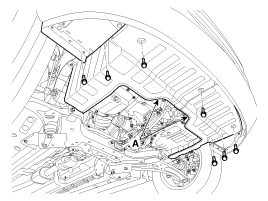
|
|
6. |
Disconnect the A/C compressor switch connector (A), the alternator
connector (B) and the cable from the alternator B terminal (C).

|
|
7. |
Disconnect the intake OCV (Oil control valve) connector (A) and
the exhaust OCV (Oil control valve) connector (B).

|
|
8. |
Disconnect the ignition coil connectors (A), the injector extension
connector (B), the VIS (Variable intake system) connector (C) and the
PCSV (Purge control solenoid valve) connector (D).

|
|
9. |
Disconnect the FPCV (Fuel pressure control valve) connector (A),
the intake CMPS (Camshaft position sensor) connector (B) and the exhaust
CMPS (Camshaft position sensor) connector (C).
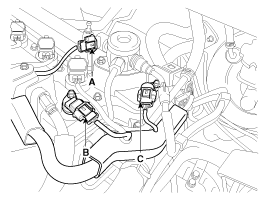
|
|
10. |
Disconnect the oxygen sensor connectors (A) and the condenser
connector (B).
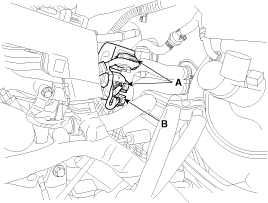
|
|
11. |
Disconnect the fuel hose (A) and the PCV (Positive crankcase ventilation)
hose (B).
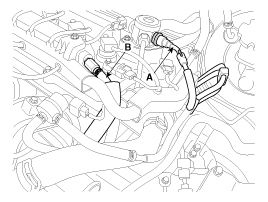
|
|
12. |
Remove the vacuum pipe assembly (A).

|
|
13. |
Remove the high pressure pipe (A). (Refer to FL group)
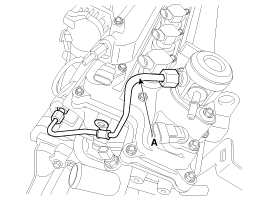
|
|
14. |
Remove the high pressure fuel pump (A) and the roller tappet (B).
(Refer to FL group)

|
|
15. |
Remove the ignition coils (A).

|
|
16. |
Remove the exhaust OCV (Oil control valve) (B).

|
|
17. |
Remove the cylinder head cover (A) with gaskets (B).

|
|
18. |
Remove the exhaust OCV (Oil control valve) adapter (A).

|
|
19. |
Loosen the water pump pulley bolt and the drive idler mounting
bolt.
|
|
20. |
Loosen the alternator tension adjusting bolt (A) to loosen tension.

|
|
21. |
Remove the alternator drive belt (A).
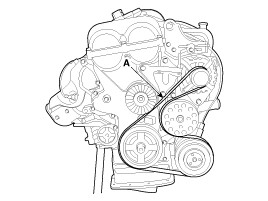
|
|
22. |
Remove the alternator (A). (Refer to Altemator in EE Group).

|
|
23. |
Disconnect the ground line (A) and then remove the engine mounting
support bracket (A).
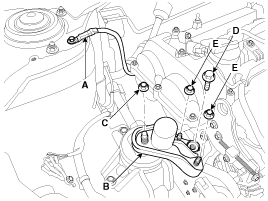
Support the engine with a jack not to be tilted.
|
|
24. |
Remove the alternator bracket (B).
|
|
25. |
Remove the engine support bracket (A).

|
|
26. |
Remove the water pump pulley (A) and the drive belt idler (B).

|
|
27. |
Remove the water pump (A).

|
|
28. |
Turn the crankshaft pulley clockwise, and align its groove with
the timing mark of the timing chain cover.

|
|
29. |
Remove the crankshaft bolt (B) and crankshaft pulley (A).

There are two methods to hold the ring gear when installing
or removing the crankshaft damper pulley.
|
|
Install the SST (09231-2B100) to hold the ring
gear after removing the starter.

|
|
Install the SST (09231-3D100) to hold the ring
gear after removing the dust cover.
|
| 1.
Remove the bracket (A).

|
| 2.
Remove the dust cover (A) and unfasten the transaxle
mounting bolt (B).

|
| 3.
Adjust the length of the holder nuts (A) so that
the front plate of the holder (B) puts in the ring gear
(C) teeth.
|
| 4.
Adjust the angle of the links (D), and fasten
the bolt 70mm(2.7559in) in the original mounted hole.

|
| 5.
Tighten the bolts and nuts of the holder and links
securely.
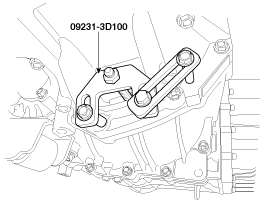
|
|
30. |
Remove the timing chain cover (A).

|
|
31. |
Align the timing marks of the Continuous variable valve timing
(CVVT) sprockets with the upper surface of the cylinder head to make
No.1 cylinder be positioned at top dead Center (TDC).
|
|
(1) |
Check the dowel pin of the crankshaft for facing upside
of the engine at this monent.
Put paint marks on the timing chain links(3 places)
that meet with the timing marks of the CVVT sprockets(In,
Ex : 2) and the CVVT sprocket.
|


|
32. |
Remove the hydraulic tensioner (A).

Before removing the tensioner, fix the piston of the tensioner
with a pin through the hole(B) at compressed position.
|
|
33. |
Remove the timing chain tensioner arm (A) and guide (B).

|
|
34. |
Remove the timing chain (A).

|
1. Timing chain
2. Timing chain guide
3. Timing chain arm
4. Timing chain auto tensionr
5. Timing chain cover
6. Drive belt idler
7. Water pump gasket
8. Water pump
...
Sprockets, Hydraulic Tensioner, Chain
Guide, Tensioner Arm
1.
Check the CVVT sprocket, crankshaft sprocket teeth for abnormal
wear, cracks or damage. Repla ...
See also:
Operation
Evaporative System Monitoring
Evaporative And ORVR Emission Control System
This system consists of below items;
-
Fill vent valve
-
...
Shift Lever Adjustment
Adjusting the control cable
1.
Set room side AT lever(shift lever) and automatic transaxle side
manual control lever to "N" position.
...
Description
Variable Intake manifold Solenoid (VIS) valve is installed on the intake
manifold. The VIS valve controls the vacuum modulator which activates a valve
in the intake manifold. The ECM opens or ...
 Kia Rio: Removal
Kia Rio: Removal






































 Components
Components Inspection
Inspection